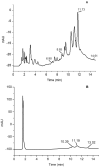Sustainable Recovery of Anthocyanins and Other Polyphenols from Red Cabbage Byproducts
- PMID: 38002214
- PMCID: PMC10669996
- DOI: 10.3390/foods12224157
Sustainable Recovery of Anthocyanins and Other Polyphenols from Red Cabbage Byproducts
Abstract
The objective of this work was to develop a sustainable process for the extraction of anthocyanins from red cabbage byproducts using, for the first time, apple vinegar in extractant composition. Our results showed that the mixture 50% (v/v) ethanol-water, acidified with apple vinegar, used in the proportion of 25 g of red cabbage by-products per 100 mL of solvent, was the best solvent for the preparation of an anthocyanin extract with good stability for food applications. The chemical characterization of this extract was performed by FTIR, UV-VIS, HPLC-DAD, and ICP-OES. The stability was evaluated by determining the dynamics of the total polyphenol content (TPC) and the total monomeric anthocyanin pigment content (TAC) during storage. On the basis of the statistical method for analysis of variance (ANOVA), the standard deviation between subsamples and the repeatability standard deviation were determined. The detection limit of the stability test of TPC was 3.68 mg GAE/100 g DW and that of TAC was 0.79 mg Cyd-3-Glu/100 g DW. The red cabbage extract has high TPC and TAC, good stability, and significant application potential. The extracted residues, depleted of anthocyanins and polyphenols with potential allelopathic risks, fulfill the requirements for a fertilizing product and could be used for soil treatment.
Keywords: apple vinegar; food color additives; organic fertilizers; red cabbage byproducts; storage stability; total monomeric anthocyanin pigment content; total polyphenol content.
Conflict of interest statement
The authors declare no conflict of interest.
Figures




Similar articles
-
Oxidative stability and Sensoric acceptability of functional fish meat product supplemented with plant-based polyphenolic optimal extracts.Lipids Health Dis. 2019 Jan 31;18(1):35. doi: 10.1186/s12944-019-0982-y. Lipids Health Dis. 2019. PMID: 30704486 Free PMC article.
-
An innovative grape juice enriched in polyphenols by microwave-assisted extraction.Food Chem. 2013 Dec 1;141(3):3268-72. doi: 10.1016/j.foodchem.2013.05.134. Epub 2013 Jun 11. Food Chem. 2013. PMID: 23871086
-
Physical character, total polyphenols, anthocyanin profile and antioxidant activity of red cabbage as affected by five processing methods.Food Res Int. 2023 Jul;169:112929. doi: 10.1016/j.foodres.2023.112929. Epub 2023 May 2. Food Res Int. 2023. PMID: 37254355
-
Pressurized solvent extraction and monolithic column-HPLC/DAD analysis of anthocyanins in red cabbage.Talanta. 2008 Feb 15;74(5):1218-23. doi: 10.1016/j.talanta.2007.08.029. Epub 2007 Sep 1. Talanta. 2008. PMID: 18371772
-
Red cabbage anthocyanins: Stability, extraction, biological activities and applications in food systems.Food Chem. 2021 Dec 15;365:130482. doi: 10.1016/j.foodchem.2021.130482. Epub 2021 Jun 27. Food Chem. 2021. PMID: 34243124 Review.
Cited by
-
Factors affecting the stability of anthocyanins and strategies for improving their stability: A review.Food Chem X. 2024 Oct 5;24:101883. doi: 10.1016/j.fochx.2024.101883. eCollection 2024 Dec 30. Food Chem X. 2024. PMID: 39444439 Free PMC article. Review.
References
-
- Pathare P.B., Opara U.L., Al-Said F.A.-J. Colour measurement and analysis in fresh and processed foods: A review. Food Bioprocess Technol. 2013;6:36–60. doi: 10.1007/s11947-012-0867-9. - DOI
-
- Bearth A., Cousin M.-E., Siegrist M. The consumer’s perception of artificial food additives: Influences on acceptance, risk and benefit perceptions. Food Qual. Prefer. 2014;38:14–23. doi: 10.1016/j.foodqual.2014.05.008. - DOI
-
- Dzah C.S., Duan Y., Zhang H., Boateng N.A.S., Ma H. Latest developments in polyphenol recovery and purification from plant by-products: A review. Trends Food Sci. Technol. 2020;99:375–388. doi: 10.1016/j.tifs.2020.03.003. - DOI
-
- Nabi B.G., Mukhtar K., Ahmed W., Manzoor M.F., Ranjha M.M.A.N., Kieliszek M., Bhat Z.F., Aadil R.M. Natural pigments: Anthocyanins, carotenoids, chlorophylls, and betalains as food colorants in food products. Food Biosci. 2023;52:1–13. doi: 10.1016/j.fbio.2023.102403. - DOI
LinkOut - more resources
Full Text Sources

